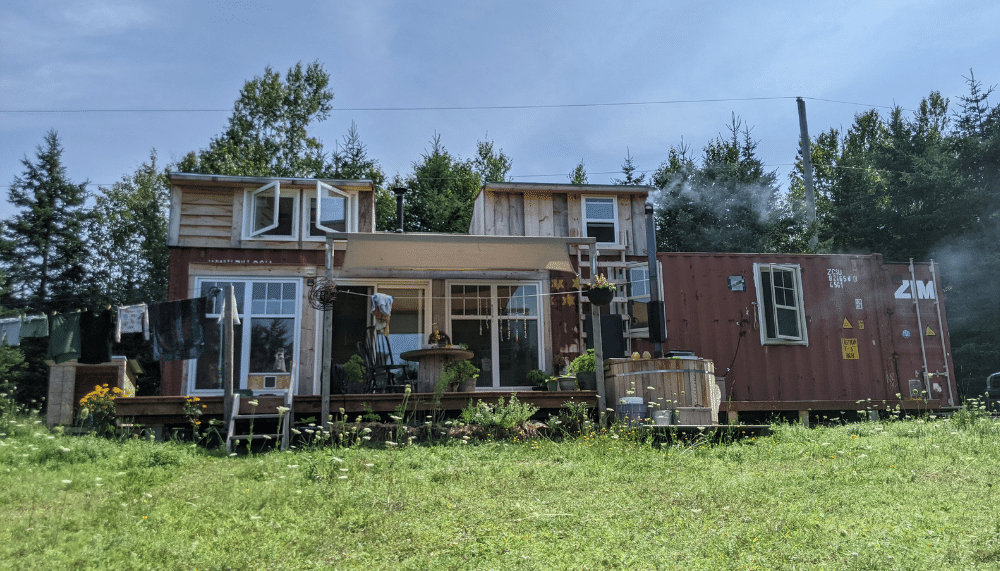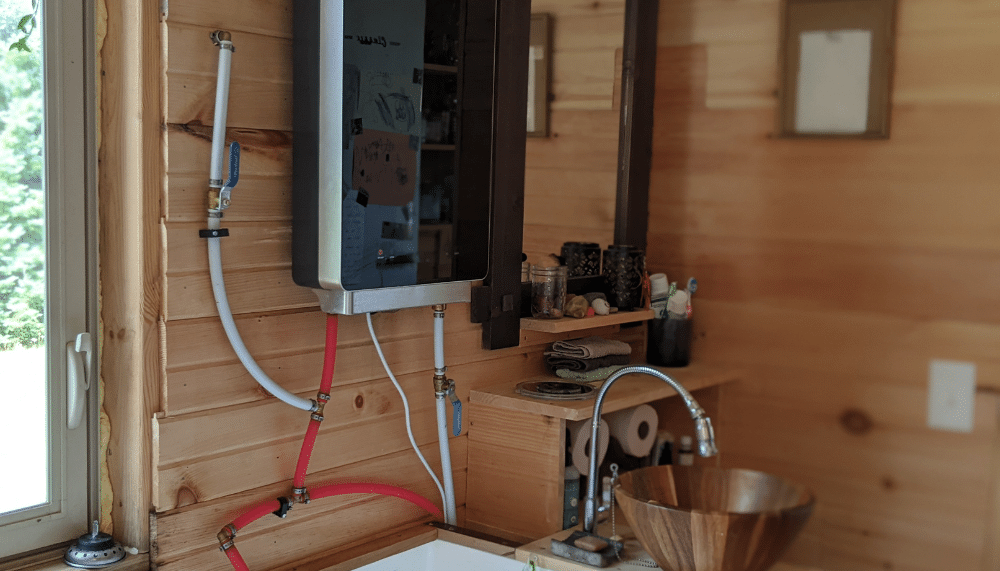Sustainable Living: Exploring an Off the Grid Shipping Container Home in PEI
Exterior view of Becka & Roger’s family shipping container home located in a rural valley of Prince Edward Island.
It has recently come to my attention that the beautiful and generous island I live on faces a housing problem. Families are struggling to find places to rent, and when they do, the rent is exorbitant.
Home prices went up around 20% in the last year in Prince Edward Island, and every time I check realtor.ca, it seems like prices keep rising. For many people, finding the right home has become a nightmare. Individuals such as Becka Viau and her partner Roger, took it as an opportunity to get creative and push the norms of housing in PEI.
After Becka got separated from her ex-partner, she and her kids couldn't afford to rent a home for $1800/month in downtown Charlottetown. Upon this radical life change, she decided to make a cultural shift and adopt an off-the-grid and mobile lifestyle. Becka started looking into investing into a tiny home around the same time she met Roger.
A few weeks ago, I had the wonderful opportunity to meet with Becka and tour her off-grid shipping container home. Today I will be sharing a bit about our time together and the intriguing details she was able to share about her sustainable lifestyle.
The Home
View of the living area, with a ladder up to one of the three lofts in the home.
The first time I walked on the property it took a moment to take in all the beauty of the space. The home might be small, but the property is immense and right in the heart of nature.
Becka's container home is located in rural PEI. The house has a bathroom, a kitchen, three lofts and one living room. These rooms seem to be more than enough for Becka, her partner Roger, two kids and three cats. The property also has plenty of room for a big deck, a chicken coop, a big yard, and a 20x10 barn.
For storage, the home utilizes space efficiently throughout the shipping container, as well of making use of the barn outdoors.
The home is not connected to amenities, so Becka had to get creative with a few things like getting water and using the toilet, but Becka explained to me, these conveniences can be integrated if someone wanted them to be. She explained that living off-grid and in a tiny house is a definite cultural shift.
“Coming closer together and having fewer things: less space, no spare rooms, no dining room or living room, and one bathroom are all things people are used to that can seem like a culture shift. You can have a flush toilet, pump your water in, and have your tiny or container home plugged into the grid. It can be super easy that way too.”
The rear exterior of the shipping container. Home to four chickens and a large storage barn.
I have to agree. I think a large part of the intiruge about tiny homes is the adaptability to less and whether or not homeowners feel like they are missing out.
One of the next questions I went on to ask Becka was how does the time passing in a tiny home? With less ‘stuff’ and space to keep you distracted, this is what she had to say:
When you live in a small house, you are spending more time outside, and it is really lovely to spend some time in nature… I have more time because I am not working as much.
When she is not looking to cut wood, fill the water jugs, empty the compost or monitoring her batteries, Becka explores the woods with her kid collecting pine cones and berries, as well as relaxes in the outdoor tub.
The Cost
One of the first questions that came to mind for me, was how much did it cost Becka to build her container home?
For Becka, building a home from a shipping container was the most affordable option because it came as a solid unit, and she didn't have to worry about finishing the outside of it. She and Roger built everything you see in the house and around the house. Roger’s skillful hands helped with everything from the hot tub and decks, to the interior organization and integrated systems.
The total cost for building a tiny home from a shipping container was around $30,000 and included the solar energy system, appliances, decks, and tub.
Looking at this project from its capital expenditure, Becka is in the green. She has a small, yet manageble debt and the precious currency of more time. Thanks to the lesser expenses, she is able to work a lot less.
“I have no bills outside the debt I have, and my cellphone, gas, truck maintenance, all these kinds of things that I have, but my bills are so low. I don’t have to work as hard to make enough money to meet ends and then have extra. It is not like I have more money than I did; I have fewer expenses.”
The Lifestyle: Living off the Grid
An alley kitchen through the central part of the home.
Another question that came to mind, was what does it really mean to live off the grid in a shipping container home?
By definition this means Becka's home is either mostly, or completely self-reliant. Off the grid is usually referring specific to energy usage, but can speak to any modern utilities deemed “essential”. The shipping container home utilizes technology, natural resources, and integrated systems, making the need for public utilities obsolete.
“A lot of shipping containers are generally tied down to septic systems, tied to a water system that is in the ground, tied to electricity, and plugged into the electric grid. We are living off the grid. It might take us two days to detach the decks, remove things off shelves in the house and pack it in two boxes and off we can go.”
This is another huge benefit to this mobility of the home. Becka explained that it takes minimal effort to prepare the container for transportation. With how hers is set up, she can have a truck come pick her up and take her anywhere across PEI for approximately $500.
Although it might seem like an established home, the shipping containers are considered mobile homes. Therefore, they do not get incentives for solar or other sustainable loans offered by the province.
I had the follow up question to find out how energy is produced in an off-grid shipping container home.
The home uses a 1000 Watts system made of 3 solar panels covers all the energy she needs to power her whole container home. The system produces more than enough energy during the summer, but there might be a need for a 4th panel for a little bit of extra energy in the winter. The home requires about 500-750 watts of electricity a day. The house needs a bit more power "around the solstice; 20th of December is the darkest day and sometimes in November because it gets quite rainy.”
The entire system cost Becka around 3000 dollars and offers all the energy she and her family needs.
Indoor wood cast iron stove. that heats the whole house
For water, Becka also has a pretty easy-to-use system. The water is pumped from an outdoor well, and it fills the two indoor barrels. The water is used for everything from gardening to washing dishes, clothes and showering. Using anywhere from 25 to 50 gallons of water depending on the day.
The whole family uses portable toilets that are transformed into humanure. Washing dishes is easy. She usually soaks dishes in a small tub of hot water and soap, which makes things easier to clean when she is ready to wash the dishes. The home is equipped with a small handmade tub and an outdoor shower.
There is also a small washing machine, which Becka uses pretty much every day. Clothes are hung to dry on a line in the yard afterwards.
I also wanted to know how life is in a shipping container throughout the winter. Especially here in PEI where we have long, cold winters with a LOT of snow.
I learned that shipping container homes are insulated pretty similarly to conventional homes. It heats up pretty quickly and keeps the heat in very well because of the smaller space. Becka has a wood stove that heats the home that takes approximately 1.5 cords of wood a year to keep warm.
“We get our wood from anybody local. Whoever has the cheapest, and then we have a smaller stove that only takes 9-inch logs, so we have to take what comes split, and then we have to split it again by hand, but that’s not bad. Some people go through 8 or 9 cords to heat a house with wood, and I am going through 2, not even 2...1.5 to heat my whole home for the entire year. ”
The beauty of their property location and landscape in a valley allows them enjoy shelter from the wind and a natural blanket of warmth in the colder months. Other than the floors getting a bit cold (not much different to any other home), the only difference is remembering the need to feed the fire a bit more throughout the winter.
The Challenges of Living in a Tiny Home
While these challenges are specific to Becka and her family, they are both definitely things to consider if you were interested in transitioning to a tiny home.
Living in Close Quarters
Becka sees this to be a bit part of the culture shift. It isn’t just about living smaller or having less space — but rather being really close to one another. She acknowledges this as being one of the biggest challenges, but also one of the best parts about it.
“The most beautiful thing about living tiny is the intimacy with the people you live with. But, on the other hand, it can be challenging, especially with the children, because everybody gets cabin fever in the middle of the winter. ”
One of the children’s private lofts.
She explains that you need to develop better communication and just get use to being around one another. The kids still have TV, toys, and their bedroom lofts in the home to have alone time. When conflict arises, she recognizes that it can be difficult to decide when to intervene as she understands the need for them to work things out on their own. Arguably, this is something apart of the growth of any family.
no internet
You can usually have internet in a tiny home or shipping container home, but Becka doesn't because of the location. A definite risk for other tiny homeowners who venture off the grid.
“I would love to get internet, but we seem to be in an unserviceable area. It is also because we are in a valley. I miss the internet because it is hard to try to run a business from here. So I miss those things, but it is nice not to be connected to my device so regularly to connect to the internet.”
She has internet on her phone, so she pays for a data plan. The connection is poor, but she sometimes gets a signal in her loft. When she doesn't, she takes it as a sign from the universe that she shouldn't focus on that thing as right now.
She downloads movies and shows from her office in town to entertain her children, where she has a good internet connection.
The YURT
Becka also owns and rents out a Mongolian Yurt. It is located on the same land but pretty far away from the property, which gives both a lot of privacy.
The yurt provides passive income for the family and allows guests to experience a similar off-the-grid lifestyle for a short period of time. The structure is equipped with 3 small panels that run lights, a charger, a fridge, a water pump system, as well as having an outdoor shower powered by propane and instant hot water.
The yurt is surrounded by nature and it is ready to welcome visitors willing to immerse in nature. When you go inside you are welcomed by a queen bed and a spacious area. If you live in PEI or soon plan to visit, I would highly recommend staying here for a few nights to have a truly unique experience.
The yurt can be rented any time during the year, except in the coldest days of winter. It is available for rent on both Airbnb and HipCamp — check out your preferred site for further details and available dates.
Hey, Claudia here
I am a senior graphic designer, a dog mom, an advocate for a zero-waste lifestyle, climate change, and sustainability. My articles are based on personal experience and well researched to give you the best source of information for all things zero-waste.













